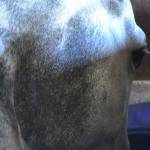Nutrition for Horses with Metabolic Disorders

How important is nutrition in a management plan for horses with these disorders?
Proper nutrition is extremely important in managing horses with metabolic disorders. Regulating the amount and type of feed, with special attention to carbohydrates, allows many horses to show minimal disease signs, maintain healthy body condition, stay comfortable, and safely perform exercise.
What is equine Cushing’s disease (ECD)?
Equine Cushing’s disease is caused by tissue overgrowth in the pituitary gland, and is most common in older horses. It is also known as pituitary pars intermedia dysfunction (PPID). Horses with ECD have high levels of adrenocorticotropic hormone resulting in increased secretion of cortisol from the adrenal glands. These horses are at higher risk of developing laminitis and may develop cortisol-induced insulin insensitivity. Clinical signs of disease are a heavy hair coat that does not shed properly, excessive thirst, excessive sweating and urination, lethargy, and loss of appetite. Pergolide, a drug that improves normal pituitary gland function, is often used in treatment.
How should a horse with equine Cushing’s disease be fed?
Cushing’s horses that are insulin insensitive require feeds with a low glycemic response (relatively mild increase in blood glucose and insulin following a meal). Carbohydrate-rich pasture and grain meals may quickly lead to laminitis in horses with ECD, but these horses must still meet their requirement for basic nutrients. For overweight horses with ECD, hay should make up the bulk of the diet. To provide vitamins and minerals, a supplement such as Micro-Max should be fed. Some ECD horses have trouble maintaining body condition. For those horses that need to gain weight, it’s still important to use feeds that produce a low glycemic response. A high-fat, low-carb ration like Re-Leve provides extra calories without boosting carbohydrate intake.
Owners should read labels to avoid the pitfall of some low-carbohydrate feeds in which starch content has been reduced but no other energy-rich ingredients (vegetable oil, rice bran, soy hulls, other sources of fat or fermentable fiber) have been included. These feeds are, in fact, low-starch, but they are also low energy, which is not what’s needed by a horse in poor body condition. The addition of vegetable oil to a horse’s grain ration greatly reduces glycemic response, and rice bran also has a low glycemic index.
What is equine metabolic syndrome (EMS)?
Equine metabolic syndrome is a condition characterized by insulin resistance and an increased risk of pasture associated laminitis. EMS horses epitomize the term “easy keeper” and often have an obese, cresty appearance. How should a horse with equine metabolic syndrome be fed?
Like overweight horses with ECD, EMS horses need to lose weight while still meeting their nutritional requirements. Hay or limited grazing can meet the forage requirement, and supplementation with a balancer such as Micro-Max can be used to assure proper nutrition. Except in cases where the horse is lame from laminitis or other causes, exercise should be increased gradually to encourage weight loss.
What is recurrent exertional rhabdomyolysis (RER)?
This condition involves abnormal intracellular calcium regulation during muscle contraction. Horses with RER suffer from painful muscle cramping when they exercise. This “tying-up” is sometimes triggered by excitement or stress, and is seen somewhat more often in young, nervous fillies than in colts in race training.
How should a horse with recurrent exertional rhabdomyolysis be fed?
Horses with RER are often training and exercising at an intense level, so they usually have a need for more calories than can be supplied by the forage portion of the diet. At the same time, high grain intakes are associated with tying-up. Research conducted at the University of Minnesota in conjunction with Kentucky Equine Research suggested that using a low-starch, high-fat feed such as Re-Leve instead of traditional grain mixes significantly reduced the amount of muscle damage in horses with RER. A suitable ration would be a feed supplying a significant part of its energy from fermentable fiber (soy hulls, beet pulp), with less than 10% nonstructural carbohydrates and over 10% fat.
What is polysaccharide storage myopathy (PSSM)?
This disorder is most commonly seen in horses with Quarter Horse breeding, drafts, and warmblood breeds. It is characterized by an abnormal glycogen accumulation in muscle tissue caused by a hypersensitivity to insulin. Physical problems range from muscle quivering and cramping to sudden collapse.
How should a horse with polysaccharide storage myopathy be fed?
Horses with PSSM are best managed on a program similar to that of RER horses, with energy and nutrients provided by a low-starch, high-fat feed. Because these horses typically do not need the same high plane of energy required by RER horses, certain concentrates have been designed to deliver dietary fortification at a lower daily intake.
What is developmental orthopedic disease?
Developmental orthopedic disease refers to a set of skeletal problems related to improper development and maturation. Joint problems like osteochondritis dissecans (OCD), cysts in cartilage, swelling, and lameness are some manifestations of defects in the process by which a young horse’s bones grow and harden.
How should a young horse be fed to minimize the risk of developmental orthopedic disease?
Research from Kentucky Equine Research has shown that feeds producing high levels of blood glucose and insulin are linked to higher than average levels of OCD. While there is more to be learned about the causes of OCD, there is some evidence that high levels of insulin caused by large grain meals may affect the maturation of cartilage cells, possibly leading to altered cartilage growth or faulty mineralization. Some commercial sweet feeds have a glycemic index as high as 129; whole oats have a glycemic index of 100. By contrast, rice bran has a glycemic index of 47, and rinsed beet pulp has a glycemic index of 34. The use of concentrates with a low glycemic index is suggested to support growth in young horses without causing a potentially dangerous starch overload.








